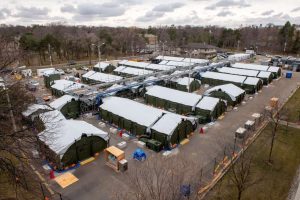Stay-at-home order needed to control third wave of COVID-19 in Ontario, science advisers say

The spread of variants of concern is dangerously outpacing Ontario’s COVID-19 vaccination campaign, health experts said Thursday, and even with a four-week stay-at-home order admissions to intensive care will likely top 800 this month.
Ford to impose Ontario-wide shutdown as 3rd wave of COVID-19 hits hard
Health officials presented the latest modelling forecast for COVID-19 this morning, ahead of an announcement that the government will impose a month-long shutdown in the province.
Dr. David Williams, Ontario’s chief medical officer of health, and Adalsteinn Brown, co-chair of Ontario’s COVID-19 science advisory table, both agreed that a stay-at-home order of at least two weeks, but preferably four in some areas, is needed to bring the worsening third wave of the pandemic under control.
The short-term projections for cases and other trends depends entirely on public health measures and the pace of vaccinations in the coming days and weeks, they added.
“These measures only work if people can understand them and follow them,” Brown said. “Partial measures, half-hearted adherence and denial” will only risk prolonging the pandemic, he added.
A stay-at-home order was last put in place in the province in January, but was lifted piecemeal in subsequent weeks as public health units moved into different phases of reopening.
Now the spread of more transmissible and more deadly variants of concern are putting unsustainable pressure on the province’s health system, the doctors said.
More than 800 admissions to intensive care units (ICUs) would be nearly double those seen during the second wave of the pandemic, when they peaked at 420 in mid-January. If ICU admissions were to reach that point, it is a “definite possibility” that physicians would need to begin implementing a triage protocol, Brown said.
“Eight-hundred is a place where we are not able to provide all of the care that we would want to people … That is a place where clinicians have to make hard decisions you would never want them to have to make,” he said.
“You will see loss of life.”
The rippling effects on the health-care system continue to touch non-COVID-19-related care as well, Brown noted. The surgical backlog is up to 245,367. Importantly, this figure only includes medically necessary procedures, and many of these patients are suffering as they await operations, he said.
Variants of concern currently account for about 67 per cent of all new infections in Ontario, the science table reported, and are causing more serious forms of COVID-19 in a younger cohort of people than seen during the first or second waves.
There has been a 41.7 per cent jump in overall hospitalizations of patients with COVID-19 in the last two weeks, Brown said.
And as of yesterday, there were 430 patients with COVID-19 being treated in intensive care units in the province, according to Critical Care Services Ontario (CCSO), the most at any single point during the pandemic. CCSO is a government agency that compiles a daily internal report for hospitals and health organizations.

The impact of variants is exacerbated by the fact that the province’s immunization effort is not doing well enough to reach the most vulnerable residents in the most at-risk communities, generally those with a high proportion of essential workers and multi-generational housing, Brown said.
“We are not vaccinating more in the highest-risk communities,” Brown said, adding that the unequal burden of COVID-19 on essential workers and their families continues to be a factor in the spread of the illness.
He also said that 40 per cent of Ontario residents aged 75-79 and 72 per cent of those aged 70-74 still have not received their first dose of the vaccine.
This morning, a group of more than 150 emergency and intensive care physicians published an open letter addressed to Ontario Premier Doug Ford and top health officials, calling for immediate and decisive action to ease the burden on hospitals.
“The current measures and framework are not working to contain the spread of this virus,” reads the letter in part. “Even if we had unlimited ICU capacity, allowing these (variants of concern) to spread exponentially is unethical.”
Sources told CBC News that Ford and his cabinet intend to announce a four-week shutdown of the province that will begin on Saturday.
Several key indicators are already more severe than when the Ford government imposed its last provincewide lockdown, which began on Dec. 26, 2020. The number of current hospitalizations is more than 20 per cent higher than those in December, as is the seven-day average of new daily cases of COVID-19.
2,557 new COVID-19 cases today
Meanwhile, the Ministry of Health reported another 2,557 confirmed cases of the illness this morning, the most on a single day since January 22.
They include 743 in Toronto, 484 in Peel Region, 311 in York Region, 131 in Ottawa, 119 in Hamilton and 107 in Durham Region.
The seven-day average of new cases climbed to 2,341, up from 1,794 a week ago.
Labs completed 62,290 tests for SARS-CoV-2, the virus that causes COVID-19, and logged a test positivity rate of 4.8 per cent.
In their briefing, Williams and Brown noted that the provincewide test positivity rate has been steadily climbing since early March and now stands at 4.7 per cent, well above the the threshold for “lockdown” in Ontario’s restrictions framework.
The ministry says that 84,060 doses of COVID-19 vaccines were administered yesterday. A total of 317,715 people have now gotten both shots of a vaccine. Ontario has now administered about 81 per cent of the 2,820,495 doses it has received from the federal government to date.
The Ministry of Education also reported 249 school-related cases, including 211 students, 36 staff members and two people who were not identified. Sixty-three, or about 1.3 per cent of Ontario’s publicly-funded schools, are closed due to COVID-19.
Education Minister Stephen Lecce said today that despite speculation, schools in the province will remain open for in-person classes after the Easter weekend and the week-long break starting April 12 will move ahead as scheduled. Both Brown and Williams stressed the importance of keeping schools open whenever possible during their briefing.
Public health units also recorded the deaths of 23 more people with COVID-19, bringing the official toll to 7,389.








Redes Sociais - Comentários